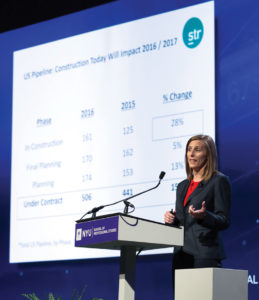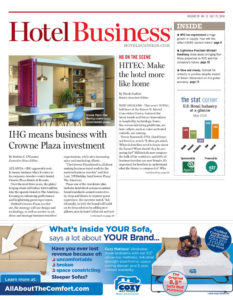NEW YORK—While second-half 2016 will undoubtedly be colored by the recent Brexit referendum that voted the United Kingdom out of the European Union, a feared plunge in the global economy does not appear part of that scenario.
Global markets did, indeed, take a dive within hours of the vote’s announcement. Less than a week later, however, they had rallied, helping to allay concern of a potential financial crisis.
The move by the U.K. could be considered just another of the so-called disrupters the lodging industry has had to deal with, although at least one top executive foresees an advantage.
“We are concerned with the fallout and uncertainty,” said David Kong, president/CEO of Best Western Hotels & Resorts. “The silver lining with the currency drop is it would probably mean more domestic and inbound travel to U.K.”
According to STR, the U.S. hotel industry reported positive fundamentals ahead of the Brexit vote, with occupancy basically flat, down 0.1% to 74.6% and average daily rate rising 3.5% to $126.89; RevPAR increased 3.3% to $94.62.
Earlier in June, Kong was among industry movers and shakers offering insight into the months ahead during the annual New York University International Hospitality Investment Conference.
STR President/CEO Amanda Hite noted Wall Street currently appeared “down” on the industry, and chalked it up to a slowing of the RevPAR growth rate.
“Starting in August of last year, we were actually seeing a decline in the growth of our RevPAR growth rate. We think that’s driving some of the more worrisome and negative sentiment around what’s going on in the industry when we still have good, solid RevPAR growth,” said Hite. With more than 74 months of RevPAR gains, Hite said she expected this to continue for the next couple of years.
“It is modest growth, but still good, positive growth. We will continue to see this barring some Black Swan event or something we could not anticipate,” she said. Whether Brexit fits those descriptors remains to be seen.
Addressing one of the industry’s key concerns, Hite noted the supply growth rate for the 12-month moving average through April was at 1.3% with demand at 2.2%. “We’re inching closer to the point where we see these two lines meet. We’re not there yet, but we do think that’s coming in our future,” she said.
Hite added the industry would “continue to see supply growth creep up through the remainder of the year. We do still think there’s room for rate growth. For 2017, we think it’s going to slow down a little. Still positive rate growth. We do not see negative RevPAR growth anytime soon in our future. Supply will be more of an issue in ’17 than ’16 at 1.9% above our long-term average of supply growth, and demand at 1.9%; 2017 is when we expect those two lines to meet.”
In adjunct data, STR and Tourism Economics forecast next year the U.S. hotel industry would see flat occupancy, a 3.8% rise to $129.66 in ADR and a 3.8% increase to $85.22.in RevPAR.
A sense of optimism for the near term remains for the industry, even as it ponders if and when the good times may no longer be a Y-O-Y occurrence.
Looking back to Q1, however, session moderator Scott Berman, principal and industry leader, hospitality and leisure for PwC, noted it was “a bit underwhelming” and that there was skepticism among some at the conference as to where the industry is headed.
“Why should we be optimistic?” he posited to his panel, which included Geoff Ballotti, president/CEO, Wyndham Hotel Group; Kevin Jacobs, EVP/chief financial officer, Hilton Worldwide; Elie Maalouf, CEO/The Americas, IHG; J. Allen Smith, president/CEO, Four Seasons Hotels and Resorts; and Best Western’s Kong.
“So many people are talking about the long-term perspective and the long-term prospects for this industry, which are, of course, amazing. So I’m getting ready to go downtown and meet with investors,” said Jacobs, noting Hilton has signed 40,000 new rooms year-to-date. “It’s pretty optimistic. The only time you get down is when people start talking about air pockets in the economy and short-term RevPAR growth. At the end of the day, low- to mid-single-digit, same-store sales growth for a sustained period of time, I think most of us would take that.”
In looking at Best Western’s performance by state and province, Kong said he flagged 17 that were down in Q1 in terms of RevPAR growth. All, however, had the mitigating factor of being affected by the energy crisis, he said. “The rest of them are all performing pretty strongly, so that gives me a lot of confidence. And when I look at the summer bookings, it’s extremely strong; probably one of the best years that we’ve seen,” said Kong.
That said, the CEO cited some macro-level conditions. “When you look at the three indicators of our industry’s health—earnings, employment growth and GDP—they are not growing robustly, but they’re not bad. But we have to recognize the tree doesn’t grow to the sky; at some point, we’re going to have a downturn. And when we have a situation where the RevPAR growth is going to be driven primarily by the rate growth, that’s cause for concern. If you look at the forecast for the next few years, that’s going to be the case. This is the time to be cautiously optimistic,” said Kong.
While stressing the industry’s fundamentals are intact and the desire for travel remains robust, IHG’s Maalouf acknowledged he was unsure what the next quarter would bring. “A little bit of healthy skepticism is not bad to make sure we are focusing on the right projects, the right ideas, the right brands, the right locations and the right deals. Irrational exuberance, as one former leader of the Federal Reserve said, is not necessarily healthy. So I think we’re optimistic, but we don’t dislike a little bit of healthy skepticism,” he said.
In looking at which impactors have and could negatively affect the industry, Four Seasons’ Smith noted most have been very localized, albeit often tragic, events. “If you look at the broader picture—the wealth creation globally, the appetite for travel, at least in our [luxury]segment where supply is—in most instances, there isn’t that looming dark cloud on the horizon where you say: ‘I’ve got to be really worried that that’s going to fundamentally change the character of the market I’m operating in,’” he said. “Recently, I feel like there’s been great examples of all the things in our industry we don’t control: overall economy, currency, Brexit, terrorism, now Zika. I expect one to dissipate and another one to emerge. I think you have to really focus on what are the things in that sort of environment that you control, and make sure you’re all over that.”
Looking ahead, Ballotti said the focus is on the company’s contribution and what it’s providing.
“Brands have never mattered more and we’re all focused on our strategies, but what are our brands contributing from a share-of-occupancy standpoint?” he observed, adding “Growing market share and helping our owners grow margin—those two metrics are what we focus on in good times.”
As of June, hotel inventory in the United States stood at 54,258 hotels (5,066,697 rooms), with 4,154 new hotels (509,607 new rooms) in various stages of the pipeline, according to HVS.
“Comparing this year with 2015, occupancy is holding steady nationwide, while average rate is still trending upward,” noted HVS Managing Partner Rod Clough. “However, cap rates are on the rise as buyer expectations for the near term are not as aggressive as those in 2015. This has created a gap between buyer and seller expectations, as well as a slowing of deals ultimately closing in 2016.”
Looking farther out, HVS anticipates values for a typical hotel in the U.S. will remain relatively flat for the next four years, said President/CEO Stephen Rushmore Jr.
“There’s a number of factors contributing to why we’re anticipating hotel values to flatten out over the next three years and rebound in 2019. [For one], more strict underwriting guidelines, which will put downward pressure on hotel values. You also have the supply pipeline, which is quite significant. And then interest rates [are]a small, contributing factor to it as well. We’re expecting a lot of those issues to work out in 2019—the supply will have been absorbed, underwriting standards will become less strict for existing assets, and for proposed assets, the underwriting guidelines will be much tougher.” HB
Nicole Carlino contributed to this article.


